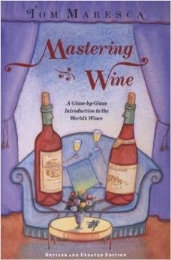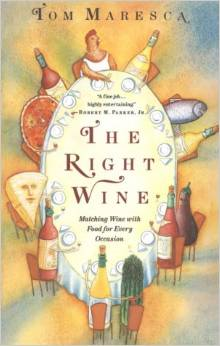Recently, Diane and I had some friends over for dinner. This isn’t an unusual event for us: We both like to cook, and we like to share our best wines with people who’ll enjoy and appreciate them.
Also, truth to tell, we don’t enjoy restaurant dining very much anymore. That’s for a number of reasons. The chief one is noise: The number of restaurants where it’s impossible to have a civilized conversation over dinner increases every year, and conversation is one of the pleasures of a good meal. Diane and I have simply stopped going to several places whose food we like very much, because we had to lean across the table and shout in each other’s face to be heard.
Prices, of course, are another factor: The number of restaurants where the cost of dinner for two represents a respectable fraction of one’s weekly income has also increased dramatically – especially if one likes wine, since restaurants continue their unenlightened policy of rack-rent mark-ups on wines.
The third major reason is the food itself: In many places, you can’t get a dish that tastes of a recognizable ingredient because there are so many of them, subjected to so much chef’s-fantasy tweaking. More and more, we find ourselves appreciating the classic French cuisine bourgeoise (which you can hardly find anywhere) and the Italian ideal of excellent prima materia treated respectfully and allowed to taste of itself. So we shop carefully and cook simply – and often, since eating is a pleasure we like to indulge on a regular basis. I read somewhere that it’s good for you.
Which loops me back to my starting point, with this further note: Another reason we like to dine at home is the added fun of matching our wines to our food – and the other way around too. So we asked some friends to a simple dinner that would accompany a few enjoyable wines. Here’s the menu we devised:
 Gougères, mixed olives
Gougères, mixed olives
Pommery Brut nv
Salad of Celery, Dates, Almonds and Pecorino
Mastroberardino Fiano di Avellino 2007
Cannelloni alla Napoletana
Marisa Cuomo Costa Amalfitana Furore 2004
Casserole-roasted Stuffed Leg of Lamb; Green Beans and Mushrooms
Chateau Talbot 1998, in magnum
Cheeses: Brebis; Robiola; Gorgonzola cremificata
Almost flour-less Chocolate Cake, Arte del Gelato Vaniglia di Madagascar
Ceretto San Stefano Moscato d’Asti nv
Espresso; grappa
 Almost all the dishes could be prepared before guests arrived and only needed to be warmed, leaving us both free to enjoy our company. As it turned out, we didn’t use the Mastro Fiano: Everyone was content to continue with the Champagne through the light, palate-refreshing antipasto salad. The marriage of the cannelloni (recipe from our first cookbook, La Tavola Italiana) and the Furore was truly made in heaven; since both the dish and the wine originate in seaside Campania, they can be said to have been childhood sweethearts who grew up together. The Marisa Cuomo estate deserves to be much better known: the quality of its wines is always excellent, and the Furore – a blend of Aglianico and Piedirosso – is particularly fine.
Almost all the dishes could be prepared before guests arrived and only needed to be warmed, leaving us both free to enjoy our company. As it turned out, we didn’t use the Mastro Fiano: Everyone was content to continue with the Champagne through the light, palate-refreshing antipasto salad. The marriage of the cannelloni (recipe from our first cookbook, La Tavola Italiana) and the Furore was truly made in heaven; since both the dish and the wine originate in seaside Campania, they can be said to have been childhood sweethearts who grew up together. The Marisa Cuomo estate deserves to be much better known: the quality of its wines is always excellent, and the Furore – a blend of Aglianico and Piedirosso – is particularly fine.
The main course lamb Diane has described on her own blog, so I’ll content myself with saying that it was rich and succulent. The pairing of almost any lamb dish with almost any Cabernet-based wine is a no-brainer, and the Talbot – that rarity in Bordeaux, a still-moderately-priced classified growth – performed admirably both with the meat and the subsequent cheese course. It also followed very nicely on the elegance and understated power of the Furore. Neither of these was an in-your-face wine: they were chosen for restraint and complexity and a willingness to play well with others. In my opinion, nothing destroys the harmony of a meal more thoroughly than a sandbox bully of a wine, a big fruit bomb that won’t let you taste anything but itself. No danger of that with either Furore or Talbot.
 From that complexity we came down lightly, with a not-very-sweet but richly chocolaty cake and a dab of ice cream, accompanied by the gentlest of dessert wines, a Moscato d’Asti from Ceretto, a Piedmont master – a kiss-on-the-cheek of a wine, the perfect finish for a comfortable dinner.
From that complexity we came down lightly, with a not-very-sweet but richly chocolaty cake and a dab of ice cream, accompanied by the gentlest of dessert wines, a Moscato d’Asti from Ceretto, a Piedmont master – a kiss-on-the-cheek of a wine, the perfect finish for a comfortable dinner.
Next morning, finishing the clean-up (it was a two-dishwasher-load dinner), we amused ourselves by trying to calculate what such a meal would have cost us in a restaurant, (if we could get it), but gave up in despair of the convolute math calculations involved. Suffice it to say that the whole evening was why we cook in the first place, and why we buy young wines and store them, even if our “cellar” is far from ideal. If you love the sensations provided by mature wines, it’s the only sensible course of action. Unless of course you have unlimited wealth – in which case you don’t need a cellar, or even a kitchen: you can buy your meal, and maybe even the quiet to enjoy it in.











